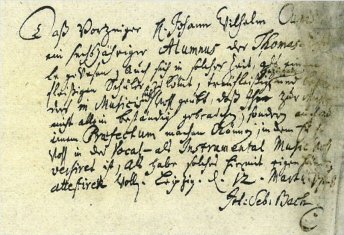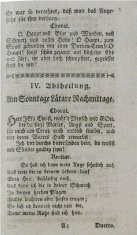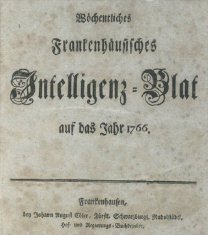|
|
Johann Wilhelm Cunis (Kantor, Bach's Pupil) |
|
Born: June 25, 1725 - Kölleda, near Erfurt, Thuringia, Germany
Died: April 4, 1796 - Frankenhausen, Thuringia, Germany |
|
Johann Wilhelm Cunis began his studies probably in a school in Kölleda. He then moved to Leipzig, where he He enrolled on June 3, 1741; and studied from 1741 to 1747; and at the Universität Leipzig from June 6, 1747. As a Thomaner he was in Choir I from May 17, 1744 (Pentecost) to June 6, 1745 (Pentecost). He is one of the few students to have been 'ennobled' by a preserved reference written by J.S. Bach. In this document only discovered in Leipzig University Archive in 2008, J.S. Bach praised Cunis' diligence in Thomanerchor Leipzig and reported that he was "so musically accomplished that in addition to being constantly chosen for musical performances, he was also appointed a prefect for being so well-versed in vocal and instrumental music." Being a prefect, Cunis was the choir's head boy and may have had to stand in for J.S. Bach on occasion. He submitted J.S. Bach's reference in 1748 in connection with his (ultimately unsuccessful) application for the Hammerianum Scholarship - a bursary for particularly gifted alumni of St Thomas's School studying at Leipzig University.
After graduation and a stint as a Kantor in his home-town of Kölleda by Erfurt (1749-1757), in 1757 Cunis became Kantor and music director in Frankenhausen. Archival research carried out recently has revealed a whole series of prints containing the words to church music directed by Cunis. It turns out that. unlike J.S. Bach, Cunis didn't write his own performance repertoire but mainly used music by other composers.
This can be seen for example from an undated booklet containing the words of a Passion, which Cunis used to break down and perform in sections on several Sundays before Easter every year. It contains a pasticcio made up of individual movements from larger works by different composers. A score of this pasticcio, which was not written out in Frankenhausen but probably in Leipzig. reveals that music by Carl Heinrich Graun, Georg Philipp Telemann and J.S. Bach had been 'recycled' for it. Accordingly, the booklet from Frankenhausen contains the words of the opening chorus of J.S. Bach's Herr Jesu Christ, wahr' Mensch und Gott, BWV 127. However. there is no other evidence (yet) to suggest that Cunis owned copies of other compositions by his teacher and performed them in Frankenhausen.
We know from Wöchentliche Frankenhousische Intelligenz-Blat ('Frankenhausen Weekly News') that Cunis also worked in other areas. It occasionally announced concerts by a Collegium Musicum made up of professional musicians, high school students and music-lovers in the Shooting club building. A detailed report in the edition dated January 8, 1766 stated that this institution had been set up by a Society of Musical Friends evidently chaired by Johann Wilhelm Cunis. It said:
"Given our duty to give credit where credit is due, it must be mentioned that ... we chiefly owe the fortunate progress of this useful institution to the praiseworthy care of our worthy music director. Johann Wilhelm Cunis"
It is striking that Cunis founded the first civic concerts in Frankenhausen, for as a student he had participated in a very similar project in Leipzig. He played the violone in the Grosses Concert. which later developed into the Gewandhaus concerts. As can also be seen from the pasticcio probably compiled in Leipzig, in Frankenhausen Cunis used ideas obtained during his period of training. He founded a lasting tradition, for the Collegium Musicum continued to perform after his death. Georg Friedrich Bischoff, one of Cunis's successors. turned the concerts in Frankenhausen into festivals of choral symphonies with monumental line-ups lasting several days which have come to be regarded as the origin of the German music festival movement in the 19th century.
References: Richter: 223; Koska: A-49; GND: 144027674; Bach Digital: 00001799 |

|

|
|
Fig. 9 : Johann Sebastian Bach Reference for Johann Wilhelm Cunis,
Leipzig, 12 March 12, 1748
The bearer Mr Johann Wilhelm Cunis spent six years at St Thomas's School. In this time, as befits a hard-working pupil, he was always truly diligent, and was so musically accomplished that in addition to being constantly chosen for musical performances, he was also appointed a prefect for being so well-versed in vocal and instrumental music. It is to this that I wish to attest in my on hand. Leipzig. 12 March 1748
Joh. Seb. Bach Kantor |
Fig. 10 : Johann Wilhelm Cunis Curriculum Vitae, Kölleda 1749
For his first appointment as Kantor in Kölleda, J.W. Cunis submitted his curriculum vitae in Latin. It included the information that he had been taught by
J.S. Bach "both publicly (in Thomanerchor Leipzig) and privately." |

|

|
|
Fig. 12 : Libretto for Passion music, Frankenhausen, c1770
Cunis' Passion perfoimance were musical highlights in Frankenhausen. The texts were printed for the audience to read duriung church services. |
Fig. 13 : Frankenhausen Weekly News.
Year: 1766. |

|
|
|
Fig. 11 : View of Frankenhausen from the South, Lithograph c1830
The Lower Church, where J.S. Bach's student Johann Wilhelm Cunis worked as Kantor, can be seen in the foreground. |
|
|
Sources:
1. Katalg zum austellung im Bach Musumleipzig (April 20-September 23, 2018; Author: Bernd Koska)
2. Bernd Koska: Bachs Privatschüler in Bach-Jahrbuch 2019, English translation by Aryeh Oron (April 2020)
3. Bernd Koska: Dissertation "Bachs Thomaner als Kantoren in Mitteldeutschland" (Beeskow 2018), Anhang VII.1 Die Alumnen der Thomasschule 1710-1760, English translation by Aryeh Oron (April 2020)
Contributed by Christine Blanken (July 2019); Aryeh Oron (April-May 2020) |
|
Links to other Sites |
|
Cunis, Johann Wilhelm (Bach Digital) |
|
Bibliography |
|
Sources: Dok V, Nr. B 593a; BJ 2008, S. 191, 199 (A. Glöckner); Koska, Bachs Thomaner (wie Fußnote 15), S. 130–136; BJ 2018, S. 34 (H.-J. Schulze)
Literature: Richter 1907, Nr. 223; Jung 2006, Nr. 18; Dok V, Nr. B 593a; Glöckner 2008, S. 191f.; Gl öckner 2009, S. 7 und 12; Kapitel V dieser Arbeit
GND: 144027674 |
|
|